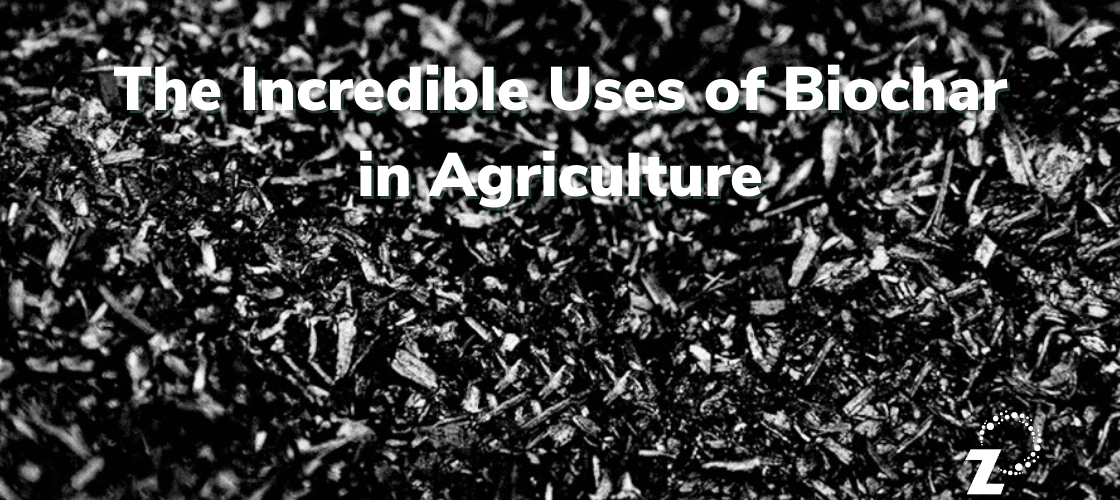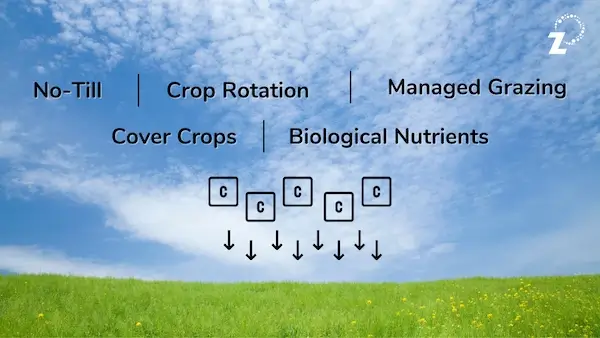
The Incredible Uses of Biochar in Agriculture
Biochar is an age-old method of improving soil health. The earliest known use of biochar in agriculture was over 2,000 years ago by the pre-Columbian indigenous people of the Amazon Basin. When scientists tested the soil in the area, they noticed how it had remained rich for over eight hundred years. This is because the indigenous people of the Amazon Basin used amended leftover charcoal from cooking fires in the soil, creating very rich and deep soils called terra preta (meaning ‘dark earth’).
In this blog post, we’ll dig into the uses of biochar in modern agriculture, and how the application of biochar can be used as part of a regenerative agriculture approach. We’ll also cover how biochar has the potential to address human health issues, improve soil and crop health, and increase agricultural productivity.
What is biochar?
Biochar is a high-carbon form of charcoal. It is black, lightweight, highly porous, and fine-grained, with a large surface area. Biochar is approximately 70% carbon. The remaining percentage consists of nitrogen, hydrogen, oxygen, and other elements. The exact composition depends on the feedstocks used to make it and the methods used to heat it.
Biochar is produced by a process called “pyrolysis”, which is the thermochemical decomposition of biomass in the absence or limited supply of oxygen (thus a different process than fire burning).
What’s the difference between biochar and charcoal?
Although it looks almost exactly like common charcoal, biochar is produced using a specific process to reduce contamination and safely store carbon. Biochar is far more efficient at converting carbon into a stable form and is cleaner than other forms of charcoal.
What is biochar made from?
Biochar can be produced from a variety of organic materials, such as corn cobs, wood chips, leaf litter, field residues, rice husks or pine wood. The material burned to make biochar is known as feedstock.
Feedstock quality has a direct impact on the quality of the final biochar product. Using contaminated feedstocks can introduce toxins into the soil, which can drastically increase soil pH or inhibit plants from absorbing minerals.
How do you make biochar?
During pyrolysis, organic materials are burned in a container with very little oxygen. As the feedstock burns, it releases little to no contaminating fumes. In this process, organic material is converted into biochar, which is a stable form of carbon that can’t easily escape into the atmosphere. The heat created during pyrolysis can also be captured and used as a form of clean energy.
- Large-scale biochar production: Large pyrolysis plants and higher amounts of feedstocks produce biochar on a large scale.
- Small-scale biochar production: Lower-cost production methods for use on the farm include modified stoves or a top-lit updraft biochar machine.
The use of biochar in agriculture
Biochar has a number of different applications:
- Burnt as an energy source
- Used in water treatment
- Added to animal feed and chicken litter,
- Applied to the land to capture carbon and improve soil quantity
- Composting
What are the benefits of biochar?
Although biochar may seem like a simple material, it has the potential to help solve a variety of global problems:
- The pyrolysis process may help sequester a billion tons of carbon annually and hold it in the soil (where it’s most beneficial) for thousands of years
- The production of biochar also produced clean and renewable energy as a byproduct, which presents an alternative to burning fossil fuels
- Contributes to food security by increasing crop yields and retaining water in drought-prone areas
- Biochar has numerous environmental benefits, such as decreasing groundwater pollution and lowering the cost of water filtration
The benefits of biochar can be summarised into four key points:
- Easy to use: Biochar is easy to apply
- Permanent effects: Biochar is so high in carbon that it doesn’t break down over time
- Environmentally friendly: 1 tonne of biochar in the ground is the equivalent of 3 tonnes of carbon dioxide permanently sequestered from the atmosphere
- Improves plant health: Biochar is proven to boost the health and vitality of nearly every type of plant
The role of biochar in regenerative agriculture
Biochar can be incorporated as a part of a larger system of regenerative carbon-based practices. These include minimal and no-till systems, green manures, cover cropping, rotational grazing, composting, and more. Biochar has an important role to play in its ability to decrease carbon mineralisation. It makes carbon more stable in the soil, while also increasing biological activity. By maximising carbon storage capabilities, biochar can assist other regenerative practices.
Biochar also works within a regenerative system to contribute to the mitigation of climate change by enriching the soil. This reduces the need for chemical fertilisers and thus lowers greenhouse gas emissions. Using biochar in agriculture also leads to improved soil fertility, stimulating the growth of plants that consume carbon dioxide.
How to use biochar to improve soil quality
The degradation of soil is a major concern in global agriculture. To address this problem, researchers suggest applying biochar to enhance soil quality. Because biochar is so pure, it doesn’t degrade, allowing for permanent soil improvement, as we saw in the Amazon.
Biochar may help improve soil quality by:
- Enhancing the structure of the soil
- Increasing water retention and aggregation
- Decreasing soil acidity
- Reducing nitrous oxide emissions
- Improving microbial properties
- Regulating nitrogen leaching
- Improving porosity
- Improving electrical conductivity
Biochar is also found to be beneficial for composting. It reduces greenhouse gas emissions, reduces the compost’s ammonia losses, and prevents the loss of nutrients in the compost material. Biochar also promotes microbial activity, which accelerates the composting process.
The role of biochar in sequestering carbon
The production of biochar is a carbon-negative process, which means that it actually reduces CO2 in the atmosphere. Here’s how it works: in the biochar making process, the unstable carbon released from decaying plant material is converted into a stable form of carbon, which is then stored in the biochar. When biochar is used in agriculture and applied to the soil, it stores the carbon in place, potentially for hundreds or thousands of years. On the other hand, if the feedstocks used to make biochar were left to decompose naturally, they would release higher amounts of CO2 into the atmosphere. Because biochar permanently locks carbon into the ground, it helps you improve your carbon footprint.

How to apply biochar for agricultural use
When using biochar in farming, it can be applied to the soils using a variety of application rates and preparation techniques. The preparation of the biochar and the rate of application will depend on the specific soil conditions and the materials used to make the biochar. Before you use biochar on your farm, you should first consider the state of your soil.
The important role of a biochar inoculant when using biochar
A crucial part of making a good quality biochar product is having the proper inoculant. To activate your biochar, you need to feed it sufficient microbes so that when the biochar is applied to the soil, it does not use up the microbes already in the soil. Biocharging (or inoculating) your biochar will actively accelerate soil recovery and mycorrhizae growth, resulting in healthier, stronger and more nutrient-dense plants.
Why does biochar need activating?
You can picture biochar as a dry sponge that needs to absorb water and plant nutrients. Once it’s done this, soil microbes will associate with the biochar and begin transferring nutrients to the plant roots. If you put raw biochar in your soil, it will take up water and nutrients from the soil until it can’t absorb any more. This can take up to six months. During this time, the plant’s roots are competing with the biochar, which can be detrimental to plant growth.
Drenching your biochar in a probiotic soil inoculant such as Tiny Team dilution in water will be the perfect activator to ensure your biochar is ready to be applied to your soil. It actively accelerates soil recovery and the associated microbiology so that you can start seeing the benefits of biochar straight away. Inoculating biochar greatly accelerates the growth of mycorrhizae, which penetrate plant root cells and improve uptake of soil nutrients.
Start reaping the benefits of biochar
Although biochar seems like a relatively simple input, it can be highly beneficial in any regenerative farming approach. It improves soil quality, sequesters carbon, and can even be used as an alternative energy source. Contact RegenZ to learn more about the beneficial use of biochar in farming.

About the Author: Alex Platt
Alex is Business Development Manager at RegenZ. He's inspired by the potential of regenerative farming and takes a special interest in the technology and products that are moving agriculture in a more sustainable direction.
3 comments on “ The Incredible Uses of Biochar in Agriculture ”
Ant Weaver
2 years agoVery interesting! If a Mac orchard already established how would you incorporate the biochar and at what rates per ha?
Orchards still to be established I assume you incorporate at the same time aa when you lime and disc in. Again what rates per ha would you recommend?
Julian Dominic
1 year agoCan you inoculate your biochar with LAB
Lactic Acid Bacteria or JMS
Hasan Microbial Solution
Shea Karssing
1 year agoThanks for your comment. Please email the team: [email protected].
Comments are closed.